spare wheel CHEVROLET EXPRESS PASSANGER 2007 1.G Owners Manual
[x] Cancel search | Manufacturer: CHEVROLET, Model Year: 2007, Model line: EXPRESS PASSANGER, Model: CHEVROLET EXPRESS PASSANGER 2007 1.GPages: 458, PDF Size: 2.62 MB
Page 288 of 458
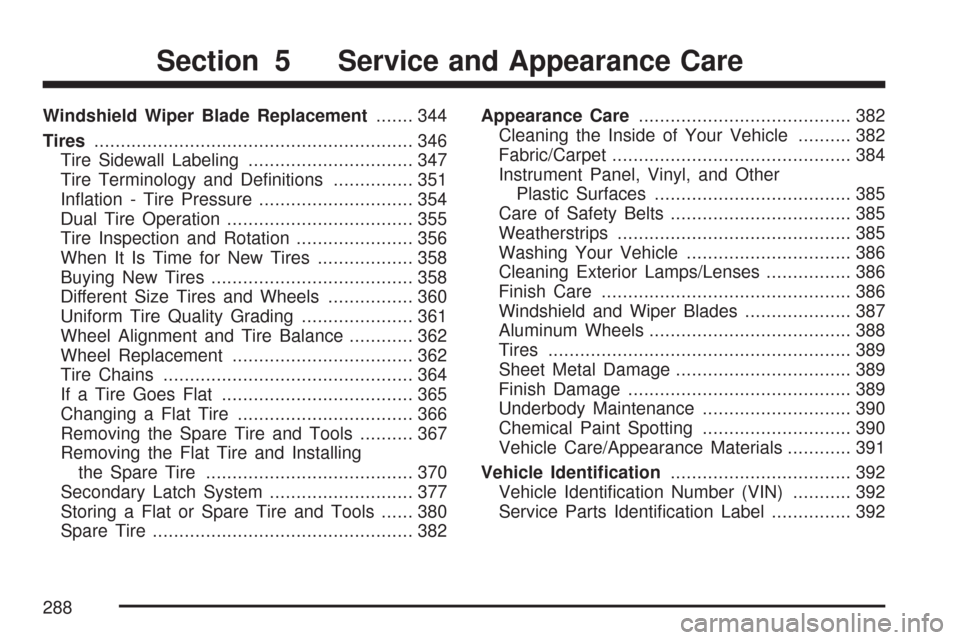
Windshield Wiper Blade Replacement....... 344
Tires............................................................ 346
Tire Sidewall Labeling............................... 347
Tire Terminology and Definitions............... 351
Inflation - Tire Pressure............................. 354
Dual Tire Operation................................... 355
Tire Inspection and Rotation...................... 356
When It Is Time for New Tires.................. 358
Buying New Tires...................................... 358
Different Size Tires and Wheels................ 360
Uniform Tire Quality Grading..................... 361
Wheel Alignment and Tire Balance............ 362
Wheel Replacement.................................. 362
Tire Chains............................................... 364
If a Tire Goes Flat.................................... 365
Changing a Flat Tire................................. 366
Removing the Spare Tire and Tools.......... 367
Removing the Flat Tire and Installing
the Spare Tire....................................... 370
Secondary Latch System........................... 377
Storing a Flat or Spare Tire and Tools...... 380
Spare Tire................................................. 382Appearance Care........................................ 382
Cleaning the Inside of Your Vehicle.......... 382
Fabric/Carpet............................................. 384
Instrument Panel, Vinyl, and Other
Plastic Surfaces..................................... 385
Care of Safety Belts.................................. 385
Weatherstrips............................................ 385
Washing Your Vehicle............................... 386
Cleaning Exterior Lamps/Lenses................ 386
Finish Care............................................... 386
Windshield and Wiper Blades.................... 387
Aluminum Wheels...................................... 388
Tires......................................................... 389
Sheet Metal Damage................................. 389
Finish Damage.......................................... 389
Underbody Maintenance............................ 390
Chemical Paint Spotting............................ 390
Vehicle Care/Appearance Materials............ 391
Vehicle Identi�cation.................................. 392
Vehicle Identification Number (VIN)........... 392
Service Parts Identification Label............... 392
Section 5 Service and Appearance Care
288
Page 355 of 458
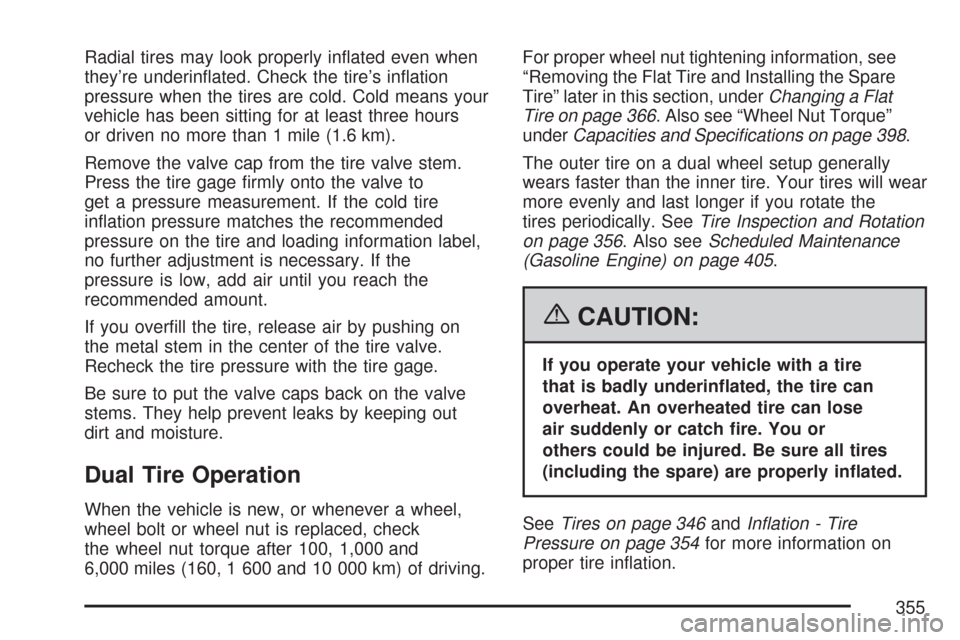
Radial tires may look properly inflated even when
they’re underinflated. Check the tire’s inflation
pressure when the tires are cold. Cold means your
vehicle has been sitting for at least three hours
or driven no more than 1 mile (1.6 km).
Remove the valve cap from the tire valve stem.
Press the tire gage firmly onto the valve to
get a pressure measurement. If the cold tire
inflation pressure matches the recommended
pressure on the tire and loading information label,
no further adjustment is necessary. If the
pressure is low, add air until you reach the
recommended amount.
If you overfill the tire, release air by pushing on
the metal stem in the center of the tire valve.
Recheck the tire pressure with the tire gage.
Be sure to put the valve caps back on the valve
stems. They help prevent leaks by keeping out
dirt and moisture.
Dual Tire Operation
When the vehicle is new, or whenever a wheel,
wheel bolt or wheel nut is replaced, check
the wheel nut torque after 100, 1,000 and
6,000 miles (160, 1 600 and 10 000 km) of driving.For proper wheel nut tightening information, see
“Removing the Flat Tire and Installing the Spare
Tire” later in this section, underChanging a Flat
Tire on page 366. Also see “Wheel Nut Torque”
underCapacities and Speci�cations on page 398.
The outer tire on a dual wheel setup generally
wears faster than the inner tire. Your tires will wear
more evenly and last longer if you rotate the
tires periodically. SeeTire Inspection and Rotation
on page 356. Also seeScheduled Maintenance
(Gasoline Engine) on page 405.
{CAUTION:
If you operate your vehicle with a tire
that is badly underin�ated, the tire can
overheat. An overheated tire can lose
air suddenly or catch �re. You or
others could be injured. Be sure all tires
(including the spare) are properly in�ated.
SeeTires on page 346andIn�ation - Tire
Pressure on page 354for more information on
proper tire inflation.
355
Page 356 of 458
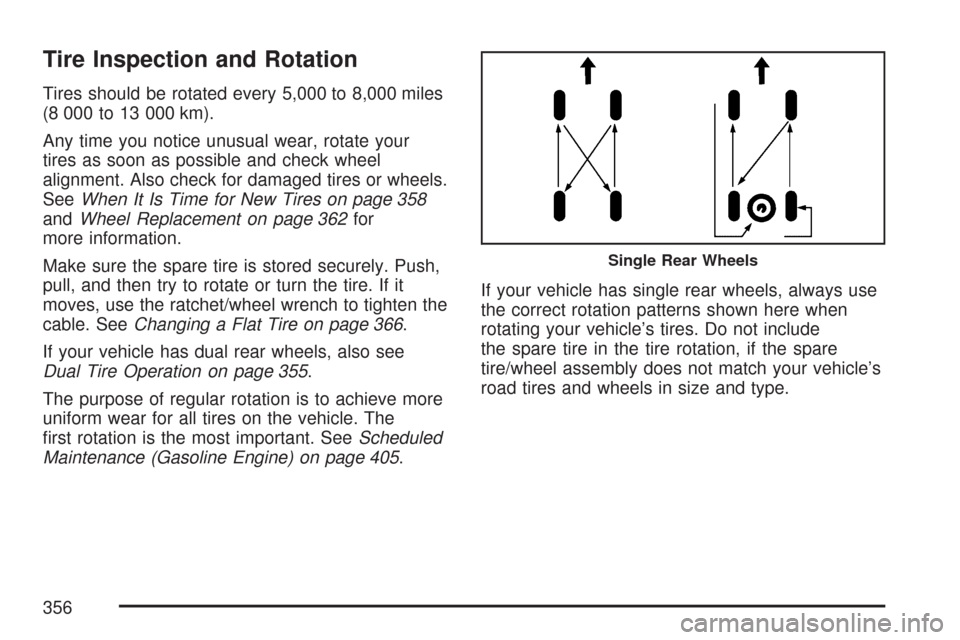
Tire Inspection and Rotation
Tires should be rotated every 5,000 to 8,000 miles
(8 000 to 13 000 km).
Any time you notice unusual wear, rotate your
tires as soon as possible and check wheel
alignment. Also check for damaged tires or wheels.
SeeWhen It Is Time for New Tires on page 358
andWheel Replacement on page 362for
more information.
Make sure the spare tire is stored securely. Push,
pull, and then try to rotate or turn the tire. If it
moves, use the ratchet/wheel wrench to tighten the
cable. SeeChanging a Flat Tire on page 366.
If your vehicle has dual rear wheels, also see
Dual Tire Operation on page 355.
The purpose of regular rotation is to achieve more
uniform wear for all tires on the vehicle. The
first rotation is the most important. SeeScheduled
Maintenance (Gasoline Engine) on page 405.If your vehicle has single rear wheels, always use
the correct rotation patterns shown here when
rotating your vehicle’s tires. Do not include
the spare tire in the tire rotation, if the spare
tire/wheel assembly does not match your vehicle’s
road tires and wheels in size and type.
Single Rear Wheels
356
Page 367 of 458
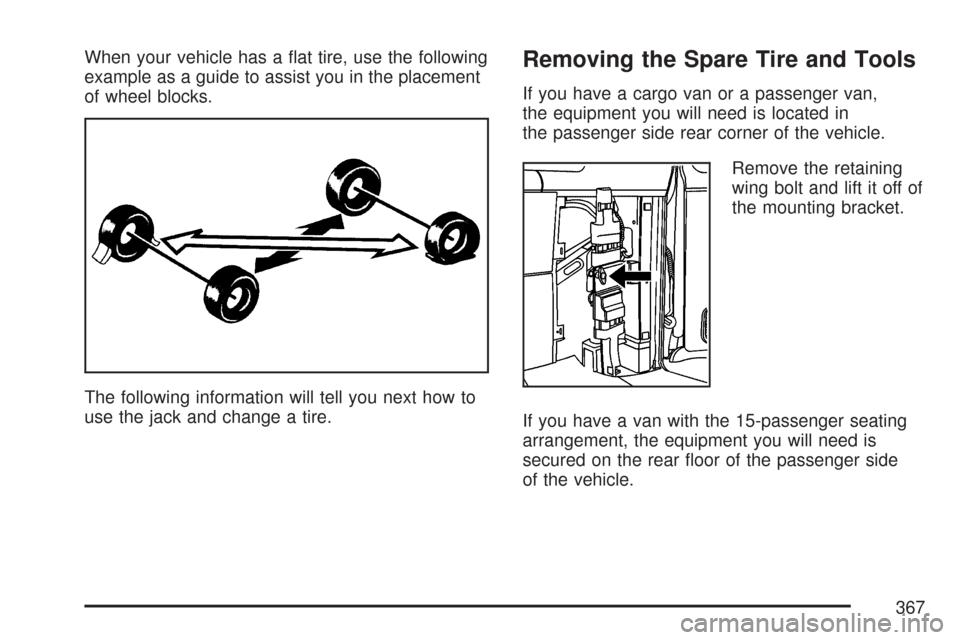
When your vehicle has a flat tire, use the following
example as a guide to assist you in the placement
of wheel blocks.
The following information will tell you next how to
use the jack and change a tire.Removing the Spare Tire and Tools
If you have a cargo van or a passenger van,
the equipment you will need is located in
the passenger side rear corner of the vehicle.
Remove the retaining
wing bolt and lift it off of
the mounting bracket.
If you have a van with the 15-passenger seating
arrangement, the equipment you will need is
secured on the rear floor of the passenger side
of the vehicle.
367
Page 368 of 458
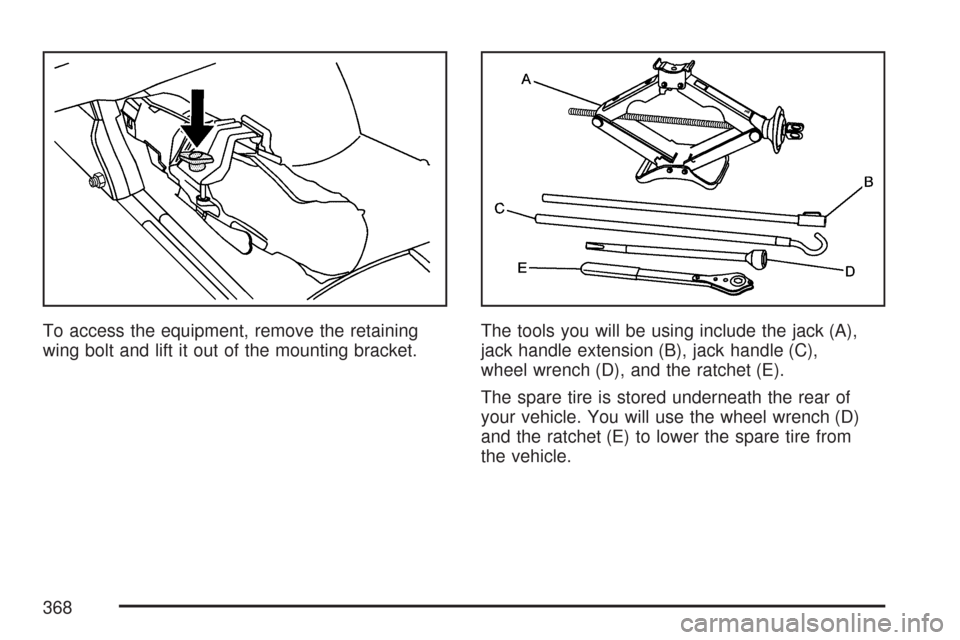
To access the equipment, remove the retaining
wing bolt and lift it out of the mounting bracket.The tools you will be using include the jack (A),
jack handle extension (B), jack handle (C),
wheel wrench (D), and the ratchet (E).
The spare tire is stored underneath the rear of
your vehicle. You will use the wheel wrench (D)
and the ratchet (E) to lower the spare tire from
the vehicle.
368
Page 369 of 458
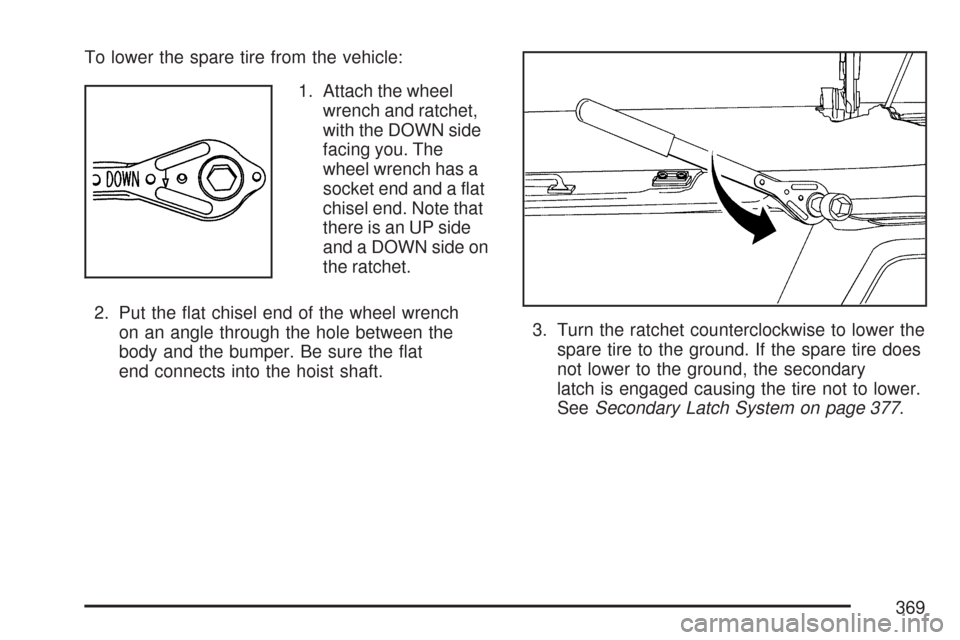
To lower the spare tire from the vehicle:
1. Attach the wheel
wrench and ratchet,
with the DOWN side
facing you. The
wheel wrench has a
socket end and a flat
chisel end. Note that
there is an UP side
and a DOWN side on
the ratchet.
2. Put the flat chisel end of the wheel wrench
on an angle through the hole between the
body and the bumper. Be sure the flat
end connects into the hoist shaft.3. Turn the ratchet counterclockwise to lower the
spare tire to the ground. If the spare tire does
not lower to the ground, the secondary
latch is engaged causing the tire not to lower.
SeeSecondary Latch System on page 377.
369
Page 370 of 458
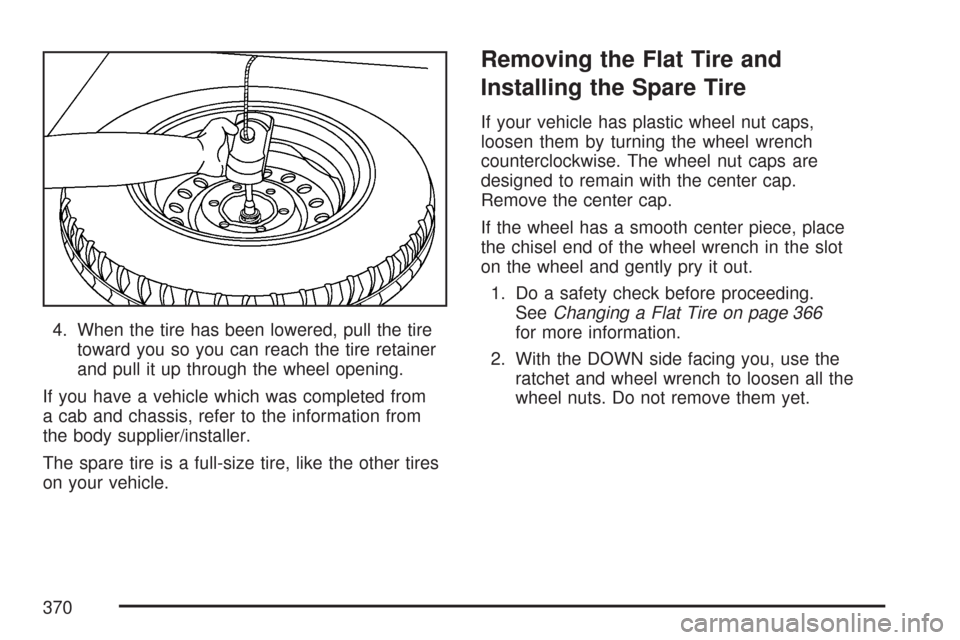
4. When the tire has been lowered, pull the tire
toward you so you can reach the tire retainer
and pull it up through the wheel opening.
If you have a vehicle which was completed from
a cab and chassis, refer to the information from
the body supplier/installer.
The spare tire is a full-size tire, like the other tires
on your vehicle.
Removing the Flat Tire and
Installing the Spare Tire
If your vehicle has plastic wheel nut caps,
loosen them by turning the wheel wrench
counterclockwise. The wheel nut caps are
designed to remain with the center cap.
Remove the center cap.
If the wheel has a smooth center piece, place
the chisel end of the wheel wrench in the slot
on the wheel and gently pry it out.
1. Do a safety check before proceeding.
SeeChanging a Flat Tire on page 366
for more information.
2. With the DOWN side facing you, use the
ratchet and wheel wrench to loosen all the
wheel nuts. Do not remove them yet.
370
Page 375 of 458
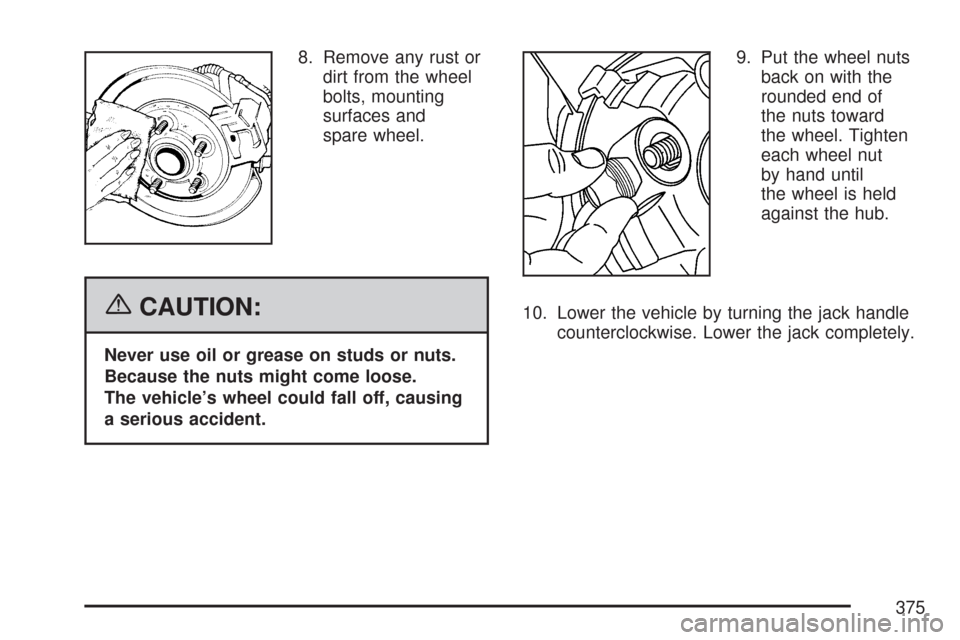
8. Remove any rust or
dirt from the wheel
bolts, mounting
surfaces and
spare wheel.
{CAUTION:
Never use oil or grease on studs or nuts.
Because the nuts might come loose.
The vehicle’s wheel could fall off, causing
a serious accident.9. Put the wheel nuts
back on with the
rounded end of
the nuts toward
the wheel. Tighten
each wheel nut
by hand until
the wheel is held
against the hub.
10. Lower the vehicle by turning the jack handle
counterclockwise. Lower the jack completely.
375
Page 379 of 458
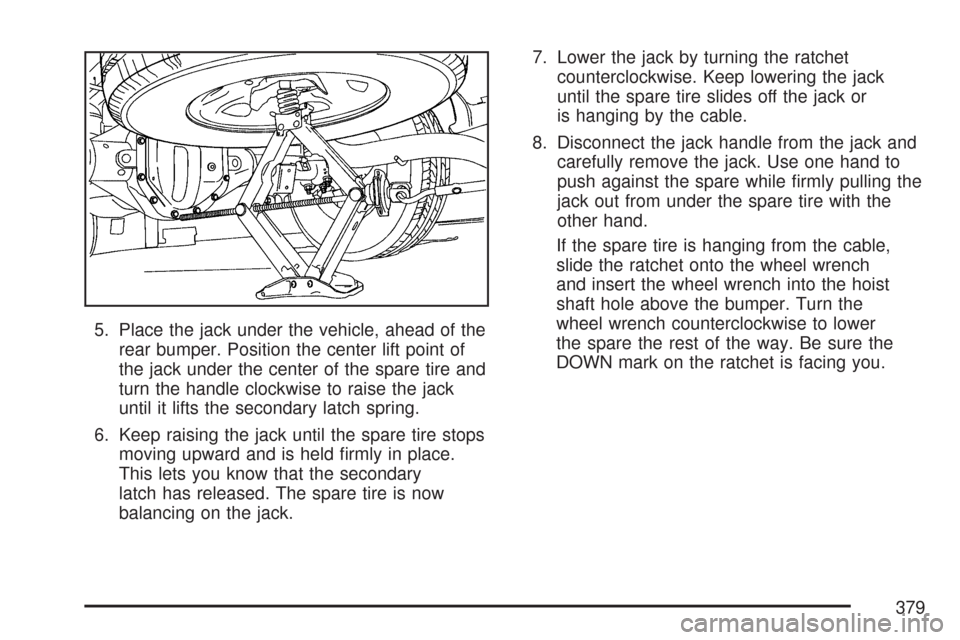
5. Place the jack under the vehicle, ahead of the
rear bumper. Position the center lift point of
the jack under the center of the spare tire and
turn the handle clockwise to raise the jack
until it lifts the secondary latch spring.
6. Keep raising the jack until the spare tire stops
moving upward and is held firmly in place.
This lets you know that the secondary
latch has released. The spare tire is now
balancing on the jack.7. Lower the jack by turning the ratchet
counterclockwise. Keep lowering the jack
until the spare tire slides off the jack or
is hanging by the cable.
8. Disconnect the jack handle from the jack and
carefully remove the jack. Use one hand to
push against the spare while firmly pulling the
jack out from under the spare tire with the
other hand.
If the spare tire is hanging from the cable,
slide the ratchet onto the wheel wrench
and insert the wheel wrench into the hoist
shaft hole above the bumper. Turn the
wheel wrench counterclockwise to lower
the spare the rest of the way. Be sure the
DOWN mark on the ratchet is facing you.
379
Page 380 of 458
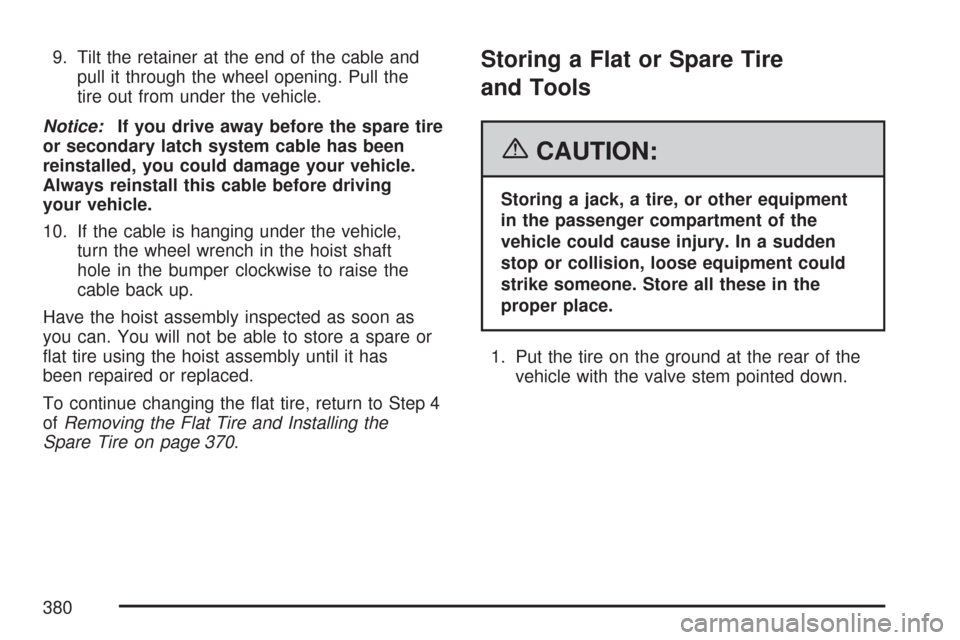
9. Tilt the retainer at the end of the cable and
pull it through the wheel opening. Pull the
tire out from under the vehicle.
Notice:If you drive away before the spare tire
or secondary latch system cable has been
reinstalled, you could damage your vehicle.
Always reinstall this cable before driving
your vehicle.
10. If the cable is hanging under the vehicle,
turn the wheel wrench in the hoist shaft
hole in the bumper clockwise to raise the
cable back up.
Have the hoist assembly inspected as soon as
you can. You will not be able to store a spare or
flat tire using the hoist assembly until it has
been repaired or replaced.
To continue changing the flat tire, return to Step 4
ofRemoving the Flat Tire and Installing the
Spare Tire on page 370.Storing a Flat or Spare Tire
and Tools
{CAUTION:
Storing a jack, a tire, or other equipment
in the passenger compartment of the
vehicle could cause injury. In a sudden
stop or collision, loose equipment could
strike someone. Store all these in the
proper place.
1. Put the tire on the ground at the rear of the
vehicle with the valve stem pointed down.
380